Testing / Performance
To test the LS753's color accuracy, we ran several images from the camera into Imatest Imaging Software. The software compares the camera's reproduced colors to the corresponding ideal of the GretagMacbeth color chart and outputs quantitative results. The color chart below expresses the results within the displayed 24 color tiles; the outer square represents the camera's produced tone, while the inner square is the corrected version by the software and the small, vertical rectangle in the center is the ideal.
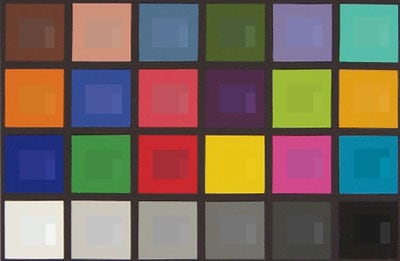
Below is a graph representing the color accuracy of the Kodak EasyShare LS753. The circles represent the tones produced by the camera, while the squares indicate the ideal. The greater the distance between the two, the larger is the degree of error for that particular tone.

The Kodak EasyShare LS753 earned an impressive 8.52 overall color score. Most of the Kodak cameras score well in terms of color rendition. Kodak attributes this to its Color Science Chip CCD that is flaunted for its color accuracy. The LS753 received an overall color error score of 7.04 and a mean saturation score of 110.2 percent. All compact cameras slightly over-saturate images to enhance skin tones and produce robust images and the LS743 follows suit with enhanced accuracy and vibrancy.
**Still Life Scene
**The image below is a shot of our attractive still life scene taken with the Kodak EasyShare LS753.
[

Click on the above image to view a full resolution version (CAUTION: the linked file is very large!)](../viewer.php?picture=Kodak-LS753-StillLifeLG.jpg)
Resolution / Sharpness ***(3.22)***
The Kodak EasyShare LS753 markets 5.36 megapixels on its CCD, with 5 of those being effective for images. When tested, most cameras fail to record their projected megapixel count; therefore, we test each camera using Imatest Imaging Software and the industry standard ISO resolution chart to determine the camera's true active resolution. A score within 70-80% of the manufacturer's count designates a 'good' performance. Within 80-90% is seen as 'very good' and anything above 90% is extremely rare and considered 'excellent.'
The Kodak EasyShare LS753 recorded 3.22 megapixels, which is only 65% of the 5.0 effective pixels that Kodak reports. For the sake of comparison, the Canon PowerShot A80 recorded 70.4% of the manufacturer's pixel count, while the similarly styled Panasonic Lumix DMC-FX5 recorded 88% of its effective 4.0 megapixels. Most Kodak imagers we have tested attained scores exceeding 70% of their marketed pixel count with the exception of the LS753's predecessor, the EasyShare LS743, which recorded 69%. While it is possible that the model we tested could have been defective, continual testing reaffirmed the disappointing 65% score.
Noise - Auto ISO ***(2.95)***
The Kodak EasyShare LS753 performed poorly when tested for produced noise using the camera's automatic ISO setting. This point-and-shoot camera is aimed at the more automatically-oriented crowd, so it is unfortunate that the Auto ISO levels produced such high levels of noise, as many of the camera's users will likely depend on the auto ISO shooting mode. The noise could be attributed to the camera's limited range of ISO speeds when in automatic mode: 80-160.
Noise - Manual ISO ***(5.89)***
The LS753 does offer an impressive range of ISO speeds: 80, 100, 200, 400, and 800. Most compact digital cameras hover in the 100-400 region. Using Imatest Imaging Software, we tested noise levels at each ISO rating. To determine the overall score, we put the noise results into a regression analysis. The graph below shows the noise at each level; the horizontal axis shows the ISO rating and the vertical axis shows the amount of noise.
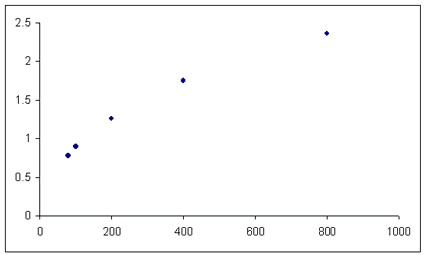
The 5.89 overall manual noise score the LS753 received indicates a vast improvement in image clarity over the camera's automatic ISO setting; however, the camera still produces high levels of noise in most images shot at ISO 200 and above. While this can be compensated for by using a flash or added external lighting, the camera is not equipped to shoot in low light scenes, even with its ISO 800 setting.
Speed / Timing
*Start-up to First Shot (6.77)
*The Kodak EasyShare LS753 takes 3.23 seconds to power up and take its first shot. This is about average for a compact digital camera, although now, many cameras are made for faster initial boot-up times.
Shot to Shot Time (8.46)
In normal mode, the LS753 takes 1.54 seconds between shots. It can do this for three shots before needing an additional six seconds afterward to write them to memory. The burst mode is located in the shooting menu. Once it has been turned on, the camera can shoot up to four pictures with only 0.36 seconds between them.
*Shutter to Shot Time (8.46)
*From the moment the user depresses the shutter button to the moment the shutter releases and captures the picture, 0.27 seconds go by.
Physical Tour
**

Front (7.5)**
The front of the Kodak EasyShare LS753 places the 2.8x zoom lens on the right side of the camera body, surrounded by a polished silver ring. The lens is retractable and is covered by a lens cover when the lens is not in use and enters the camera body. Above the lens ring and slightly to the right, the user will find the light sensor for the camera, a feature which could potentially be covered by a finger during still image or movie capture. Moving to the left of the light sensor is the real image optical viewfinder. Next to the viewfinder along the top of the camera body is the self-timer/video light with the centrally located microphone for audio capture to the left of that. Finally, the last feature on the top of the front face is the built-in rectangular flash. The wrist strap eyelet is located half-way up on the left side of the front face.
**

Back (8.5)**
The top left corner on the back of the Kodak EasyShare LS753 features an undersized real image optical viewfinder that is awkwardly placed. Directly beside the viewfinder, located within the plastic square surrounding the unit, the user will find the ready light, which allows the user to become aware of when the shot has been established and the shutter can be depressed. The center of the camera's back features the 1.8-inch LCD screen; big enough for easy viewing and set in enough that solarization does not appear too quickly when rotating the camera away from direct eyesight. Running along the left side of the LCD are a series of buttons which control specific parameters within the camera. The top button is the Delete button, which allows the user to edit video and digital still footage from the camera's memory card or the 32MB internal memory. Beneath the Delete button is the Menu button, which allows the user to enter and disengage the onscreen LCD menu for camera control and manual control options. Under the Menu button is the Review button, which allows the user to view previously captured video and still images. At the bottom of the row is the Share button, which allows images to be transmitted between cameras or exported to computers or printers. Each button is clearly labeled, with the Share button accentuated by its red color.
Running along the right side of the back of the LS753 are LED lights that are shaped like the functions they indicate: a camera with the word 'auto,' a person's head for portrait mode, a flower for macro mode, 'SCN' for the preset scene modes, a video camera for movie mode, and a heart for the favorites album. Users can engage these modes using the jog dial on the top of the camera. When in scene mode, the user can choose between 13 general environmental situations, allowing for some personal modification to occur. The LED lights are a great functional addition to this camera, allowing for fast and simple control adjustments to be made knowingly and precisely by the user. Plus, they're interesting to look at. In the upper right corner of the camera’s back side is the four-way controller with the centrally located 'OK' button, which is depressible when engaging controls on the menu, or when changing between category headings and subsection menus. Surrounding the four-way controller is the zoom control ring, which allows the user to engage wide angle and telephoto control options.
**

Left Side (8.0)**
When viewed from behind, the left side of the Kodak EasyShare LS753 features one rubber port cover, which is opened by lifting the tab located at the base of the camera. This tab swivels out of the way of the ports beneath, allowing for easy access. The construction appears to be sturdy, which enables use over extended periods of time. The ports beneath are USB, Video out, and DC in, from the top and moving down.
**

Right Side (8.0)**
The right side of the camera houses a battery and an SD/MMC memory card slot beneath a sturdy plastic door. The door flips outwards from a tab located towards the front of the camera body. On the inner side of the door, the user will find instructions for both proper battery placement and memory card slot orientation.
**
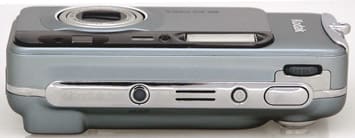
Top ***(8.0)*
The top of the camera body features several key controls for the Kodak EasyShare LS753. On the right side of the camera body is a jog dial for selecting camera modes on the LCD screen. Behind the jog dial is the shutter button for the Kodak EasyShare LS753, which emits the most irritating 'Game Boy'-like sound effects when engaged. Luckily, these sounds can be disengaged on the setup menu. To the left of the shutter button is the flash control button, which allows the user to control flash settings on the LCD screen through the flash control menu. Next to this, in the center of the camera body, is the speaker for audio playback while reviewing in-camera footage. To the left of the speaker is the on/off button for the camera, highlighted by a centrally positioned LED for easy initiation and disengagement.
Components
**
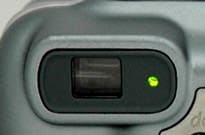
Viewfinder ***(4.5)*
Rely on the LCD screen on the Kodak EasyShare LS753, because the viewfinder is undersized and awkwardly placed. The real image optical viewfinder’s pitiful size makes use nearly impossible, and when paired with the fact that the viewfinder only sees 80 percent of the captured field, its presence on the camera seems arcane and nostalgic.
**
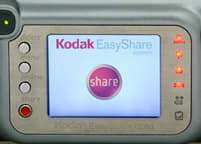
LCD Screen ***(6.0)*
The Kodak EasyShare LS753 has a sizable and nicely placed 1.8-inch LCD screen to make up for its lack of a decent viewfinder. The 134,000-pixel hybrid LCD screen is located on the back of the camera and is flush with the camera body. The LCD can be turned on and off manually; it also engages automatically when the camera is turned on, a standard feature on most digital cameras available today.
**
Flash ***(6.0)*
The flash of the Kodak EasyShare LS753 has manually controllable parameters that can be engaged through the flash button located on the top of the camera body next to the shutter button. The flash setting will appear on the LCD screen and can be changed by depressing the flash button until the proper setting is highlighted. The flash settings available are Auto, Off, Fill, and Red-Eye Reduction. The flash is effective from 2-10 feet in wide angle mode and 2-5.9 feet in telephoto mode.
**
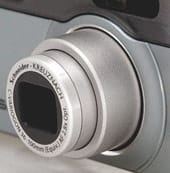
Zoom Lens ***(6.0)*
The 2.8x optical zoom lens is 6-16.6mm long, which is comparable to 36-100mm on a 35mm-format camera. It also has digital zoom ratings of 3.6x. It should be noted that when digital zoom is used, the overall image quality will be compromised. The optical zoom is fairly shallow, especially for a camera at this price. The 2.8x optical zoom limits the accessibility of the subject and tightness of the crop, among other things.
**Memory ***(8.0)*
The Kodak EasyShare LS753 accepts an SD/MMC memory card via the slot located on the right side of the camera body. It is also equipped with 32MB of internal memory for still and abbreviated video footage. The user would benefit from purchasing an optional memory card if longer footage or higher quality images are desired.
Design / Layout
**Model Design / Appearance ***(7.5)*
The Kodak EasyShare LS753 is sleek and smooth, with a bluish silver metallic body and clean lines throughout. The LCD screen fills the back of the camera body, measuring a sizable 1.8 inches. The 2.8x zoom lens is covered by a retractable lens cap when recessed into the camera body. Many of the buttons and other features are neatly lit from beneath with a series of bright LED lights, allowing for easier navigation through the menus or controls on the camera body during low or no light situations. There is a slightly raised ribbed square on the front face of the camera that appears to be wholly decorative and adds appeal to the overall aesthetic.
**
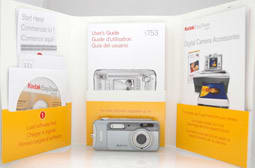
Size / Portability ***(7.5)*
The Kodak EasyShare LS753 has a long body with a relatively slim profile. This camera could neatly fit into a pocket if the user doesn’t mind that the body is 4.3 inches long; either way, the camera does neatly fit into the palm of the user's hand when not in use. There is a wrist strap eyelet on the right side of the camera, near the shutter release button. The zoom lens retracts into the camera body and the buttons are all nearly flush with the surface of the camera, making accidental engagement during everyday usage nearly impossible. The LS753 measures 4.3 x 1.9 x 1.2 inches and weighs 5.8 ounces without the batteries, making it a practical choice for consumers who value portability.
**Handling Ability ***(7.5)*
The camera’s slim design and compact nature make it simple to hold and shoot with one hand, although the sleek body could become problematic if the camera body or the user’s hands became wet. The buttons are all easily within reach, and shooting still images is straightforward. However, like so many digital cameras today, the viewfinder appears to be an afterthought or purely nostalgic inclusion. Although there are no overt grips for the hand, the user will still find the camera easy to hold due to the short height of the frame and its relatively thin design. There is a slightly ribbed section on the back of the camera body on the left side, directly beneath the viewfinder to supply additional grip for the thumb of the left hand. The microphone is placed centrally on the front of the camera body, out of reach of wandering fingertips while shooting movies.
**Control Button / Dial Positioning / Size ***(8.0)*
The controls on the Kodak EasyShare LS753 are all fairly easy to discern, with the majority of functions accessible through onscreen LCD menus. The four-way controller is slightly raised from the camera body; however, even though it is fairly easy to use, the small size of the control may confound the less dexterous users. The dial located on the top of the camera, in front of the shutter button, allows the user to scan preset features and is at once rotational to highlight features, and depressible to engage selected features. Many of the controls and buttons are LED-based, allowing the user to quickly discern and execute camera control changes without excess labor.
**
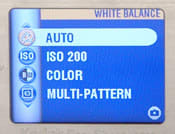
Menu ***(7.0)*
The menu is accessed via the clearly labeled Menu button to the left of the LCD screen. The menu options differ based on which shooting mode is being used. In the Auto mode, menu options include self-timer, exposure compensation, burst, pictures quality, white balance, ISO speed, color mode, exposure metering, focus zone, long time exposure, image storage, set album, and setup menu. (Don't be fooled by the title of the mode. The Auto mode can essentially function as a manual mode, with control over exposure and shooting settings). In Portrait mode, menu options include self-timer, exposure compensation, burst, picture quality, white balance, color mode, exposure metering, focus zone, image storage, set album, and setup menu. In the close up mode, menu options include self-timer, exposure compensation, burst, picture quality, white balance, ISO speed, color mode, exposure metering, focus zone, long time exposure, image storage, set album, and setup menu. When in the Scene mode, the following menu options are available: self-timer, burst, picture quality, color mode, image storage, set album and setup menu. Within video mode, the menu offers options for self-timer, picture quality, set album, video length, image storage, and setup menu. In the Favorites mode, the following menu options appear: slide show, multi-up, picture info, remove favorites, and setup menu.
**Ease of Use ***(7.5)*
The Kodak EasyShare LS753 is fairly easy to use. The full word titles in the menus give the user faster access, and the arrangement of features is logical. The scene settings, however, are tedious to alter, and the four-way controller with the depressible OK button is undersized and occasionally forced me to select options I did not wish to engage. The programmable Auto mode is a nice hybrid feature, and it’s simple to switch between it and other modes.
Modes
**Auto Mode ***(8.0)*
When the camera is placed in Auto Mode, the user can choose to leave all control options to the camera, or they can alter control settings through the Menu button on the left side of the LCD screen. Auto mode and manual mode appear to coexist on this camera, making the degree of manual control a decision dictated by the user, with automatic presence always remaining a possibility if the user is unsure of control settings during shooting. All manual controls available to the user are accessible to the user through the auto mode.
**Movie Mode ***(5.0)*
When the Kodak EasyShare LS753 is in movie mode, the user can shoot video at 320 x 240 at 20 frames per second or 640 x 480 at 13 fps. The 20 fps video is smooth for a digital camera and fairly even; it is activated and deactivated through the depressing of the shutter button. It is possible to control zoom while shooting in movie mode on the Kodak EasyShare LS753, an option sometimes overlooked by other cameras. Audio is recorded via the microphone located on the front of the camera body in the upper center portion of the face.
**Drive / Burst Mode ***(7.5)*
Within the onscreen menu, the user can select the continuous shooting option for up to four pictures at a rate of approximately 2.4 frames per second. Flash, self-timer, and long time exposure are all unavailable when in burst mode. The number and rate of image capture is fairly unimpressive, especially with a camera of this price range.
**Playback Mode ***(7.0)*
The user can select playback mode by pressing the review button on the left side of the LCD screen. To scan between pictures, the user must press the right and left arrows on the four-way controller located in the upper right-hand corner on the back of the camera body. If users wish to view images in multi-up mode, they must first press the review button and then press the down arrow to initiate this setting. It is also possible to magnify selected pictures in playback mode using the playback 8x zoom available through the zoom control ring. The LS753 can also play pictures in a slideshow and protect photos from being formatted. This camera also has options to store photos in separate albums on the internal memory. To make viewing easier, Kodak programmed the camera to automatically rotate pictures.
**Custom Image Presets ***(7.5)*
The user can choose from a number of image preset options from the scene menu, which is accessed through the jog dial. Once the scene setting is selected, the user can choose among the following 13 modes: night landscape, night portrait, sport landscape, snow, beach, party, self-portrait, manner/museum, fireworks, backlight, flower, and children. It is also possible to select between close-up and portrait mode in the same menu as the scene selection parameter.
Control Options
Manual Control Options
The user of the Kodak EasyShare LS753 can control Zoom, Exposure Compensation, White Balance, Shutter speed, aperture opening, and ISO Speed. There are also preset scene modes available through the jog dial. Flash control is dictated through the Flash button on the top of the camera body with settings appearing on the LCD screen.
**Focus
***Auto (8.0)*
There are two automatic control settings available to the Auto Focus parameters on the Kodak EasyShare LS753. When the user enters the menu control settings, there is the option to highlight the Focus Zone subsection. Once highlighted, the user can choose either the center-weighted Center Zone setting, or the Multi Zone overall frame setting. The LS753 can focus as close as 23.6 inches in normal shooting mode. In macro mode, subjects can be as close as 2 inches.
Manual (0.0)
There is no manual focus mode on the Kodak EasyShare LS753. The user can control the focus zone parameters established through the menu button control.
**Metering ***(7.5)*
The user can select the Exposure Metering section of the onscreen Menu to bring up the two metering settings on the Kodak EasyShare LS753. The Multi-pattern setting is the default camera setting and evaluates the lighting conditions throughout the image. Center-weighted evaluates the conditions of lighting in regards to the subject centered in the frame, a tool best used when the subject is backlit. Finally, Center-spot allows the user to select a portion of the potential image to be captured prior to returning the camera to the framing position desired and the image captured. This setting is best used if a specific portion of the frame’s metering is needed for evaluation.
**Exposure ***(7.0)*
There is no outright manual exposure control, but there is an Exposure Compensation setting available through the menu settings within the onscreen LCD menu. Exposure Compensation allows the user to select between -2 to +2 with 1/2 EV steps. The exposure setting allows for the user to control the amount of light entering the camera during image capture. The exposure ranges from Wide EV 4.2-15.2, (.5 sec. at f/3.0 to 1/400 sec. at f/5.1) to Telephoto ratings of EV 5.6-16.6 (1/2 sec. at f/4.9 to 1/1400 sec. at f/8.5).
**White Balance ***(5.0)*
White Balance can also be controlled manually on the Kodak EasyShare LS753. To change the setting, the user must enter the onscreen menu and highlight the White Balance subsection. The white balance controls are all presets, but can be selected by the user between the default Auto mode, Daylight, Tungsten, and Fluorescent mode settings. Although there are options, this is a rather limited number of presets and without a customizable setting, more complicated lighting situations will potentially suffer.
**ISO ***(8.5)*
ISO on the Kodak EasyShare LS753 is manually controllable, and is established by entering the onscreen LCD menu and choosing between 80, 100, 200, 400, and 800. ISO 800 is only available when image quality is set at the Good level. When the camera is set with Automatic mode, the range is drastically reduced to between 80 and 160 ISO. The ISO speed settings control the sensitivity of the camera to specific lighting situations.
Shutter Speed ***(2.0)***
The shutter speed is controlled through a setting on the camera referred to as a Long Time Exposure, and allows the user to select either 0, 1, 2, 4, 8, and 16 seconds. When in this setting, the Exposure Compensation setting is set to zero and the ISO will be set to Auto. The shutter speed is mechanical, with the CCD being set electrically between 1/1400-16 seconds.
Aperture ***(0.0)***
The aperture settings for the Kodak EasyShare LS753 are automatic and controlled, along with the shutter speed, to give the user of the camera proper exposure ratings. The F-stop ratings for this camera are f/3.0-f/5.1 from a half-second to 1/1400th of a second when the wide angle lens is engaged. When the telephoto portion is engaged, the range is f/4.9-f/8.5 from a ½ second to 1/1400th of a second.
Image Parameters
**Picture Quality / Size Options ***(7.0)*
The user of the Kodak EasyShare LS753 can select between four different picture quality ratings of Best (2560 x 1920), Best (2560 x 1706 - 3:2 ratio), Better (2048 x 1536), and Good (1496 x 1122) for still images. The Best option with the 3:2 ratio is designed specifically for producing 4 x 6-inch prints. The camera has video capture settings of 320 x 240 and 640 x 480 with frame rates of 13 and 20 frames per second, respectively.
**Picture Effects Mode ***(6.0)*
With the Kodak EasyShare LS753, the user can select between several picture effects available within the camera. These effects are Color, Black and White, and Sepia; this list lacks the standard picture effect options available on most digital cameras.
Connectivity / Extras
Connectivity
Software*(8.0)*
The software packaged with the Kodak EasyShare LS753 is for both Macintosh and Windows platforms, and can be used in the editing of still and video footage, or for printing options via personal computer.
**
Jacks, Ports, Plugs (7.0)
The Kodak EasyShare LS753 has a port cover located on the left side that, when lifted, allows the user to access the DC in, the USB port, and the video out port. The direct print docking terminal is located on the bottom of the camera body.
**
*
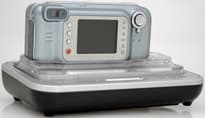
Direct Print Options **(8.5)*
It is possible to dock your camera to a Kodak EasyShare printer without a computer. The red Share button is intended to provide one-touch printing. It actually ends up being two- or three-touch printing; the user must select the print option, then the quantity of prints desired.
Other Features ***(5.0)***
Self-timer
The Kodak EasyShare LS753 includes a ten-second self-timer.
Sound effects
Selectable sound themes include Standard, Classical, Sci-Fi, Fun, Off, and Shutter only.
Overall Impressions
**Value ***(7.5)*
For this price, getting a 5 megapixel CCD is appropriate, as are the sleek and smooth features and the nicely sized 1.8-inch LCD screen. However, the zoom only rates at 2.8x optical, and the camera does not include an optional memory card, forcing the user to initially rely upon the internal memory provided with the camera. This camera is definitely among the higher end of the point-and-shoot cameras.
Comparisons
[

Kodak EasyShare LS743 *](../content/Kodak-EasyShare-LS743-Digital-Camera-Review.htm)- *This predecessor to the LS753 comes with a smaller CCD of only 4 megapixels, but a comparable 2.8x optical zoom lens for the retail price of $349. It has no lens ring accessory ability, and the overall design is very similar to the LS753’s. Like all Kodak EasyShare cameras, it is Direct Print-capable. It has only 16MB of internal memory, and is capable of capturing either video or still image footage. It has a real image optical viewfinder, a 1.8-inch LCD, and a 1/2.5-inch CCD.
**
[
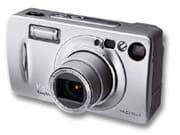
Kodak EasyShare LS443*](../specs/Kodak/EasyShare%20LS443.htm) - *This camera, also by Kodak, sells for $399.95, but comes with a less powerful 4.2 MP CCD. The 3x optical zoom lens is slightly larger than that of the LS753, and the 1.8-inch LCD screen is identical to that of the LS743 and LS753. The 16MB of internal memory is also smaller, giving the user only half the internal memory of the Kodak LS753.
**
**
**[
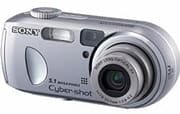
Sony Cyber-shot DSC-P93](../content/Sony-Cyber-shot-DSC-P93-Digital-camera-Review.htm) - *This camera is priced slightly lower than the LS753, retailing for $329.95. It has a 3x optical zoom lens, the potential for direct printing, and a 1/1.8-inch 5.1 MP CCD. However, it falls short of the Kodak LS753 with a smaller 1.5-inch LCD screen. It has a fantastic amount of manual control available, unlike either the LS743 or the LS753. This camera is also capable of capturing video at 640 x 480 resolution with audio at a speed of 30 frames per second.
**
[
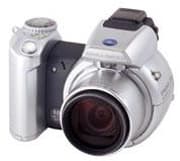
Konica Minolta DiMage Z2*](../specs/Konica-Minolta/DiMageZ2.htm) - *This Konica is included to offer a comparison with a camera that has a quite impressive zoom range, with a 10x optical rating. This camera goes above and beyond the other cameras in this section. However, it does have a much smaller CCD, at only 4.0 MP.The Konica Minolta DiMage Z2 has such features as fast focus and a super macro mode, and is comparably priced at $324.95.
**
**
Who It's For
*Point-and-Shooters - *For the point-and-shoot user with a bit of money, this camera looks great and feels great. Its controls are straightforward and uncomplicated.
**
Budget Consumers- Considering what the camera provides, it appears that a fair amount of the price can be attributed to the aesthetics and ease of use. Less expensive products with similar options are readily available.
**
Gadget Freaks- This camera may look like an attractive option for the gadget freak, with its nicely lit controls and LED lights all over the camera body. However, there are few functional features or gadgets available. The gadget freak would enjoy the sleek and glamorous exterior, but would become bored and look elsewhere.
**
Manual Control Freaks- Some manual controls are available to the user of the Kodak EasyShare LS753. However, this camera is weighted more toward the point-and-shoot consumer.
**
Pros/Serious Hobbyists— Neither the pro nor the serious hobbyist would find themselves in desperate need of the Kodak EasyShare LS753. Its foundation is in automatic shooting and lacks real user control beyond the basic functions.
Conclusion
Conclusions
Kodak’s EasyShare LS753 has been designed for the point-and-shoot consumer seeking lots of automatic control settings but with the possibility for manual control. It has a nicely sized 1/2.5-inch 5 MP CCD, and a 1.8-inch LCD screen. The menus are set up neatly, with full word headings and clear subsections, and even if some of the controls are undersized, all of them are easily accessed. The LS753 gets poor marks for its impractical viewfinder, with only 80 percent frame coverage, and the fact that, at $349.95, the 2.8x optical zoom lens seems a little paltry. This camera is great for the more financially carefree user who wants an aesthetically pleasing point-and-shoot camera that is easily navigated.
Specs
Specs Table
{{manufacturer_specs_table}}{{raw_scores_table}}
Meet the tester

James Murray
Editor
James Murray is a valued contributor to the Reviewed.com family of sites.
Checking our work.
Our team is here for one purpose: to help you buy the best stuff and love what you own. Our writers, editors, and lab technicians obsess over the products we cover to make sure you're confident and satisfied. Have a different opinion about something we recommend? Email us and we'll compare notes.
Shoot us an email